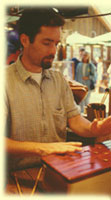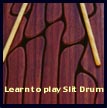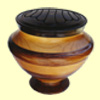
Slit Drums
Click images for enlarged view

What is the history of the Slit Drum?
 The
Slit Drum is one of the world's oldest known instruments. They have been
a part of African, Asian and South American cultures for hundreds of years.
These drums were first made from hollowed out trees which were struck with
sticks to create tones. In some African cultures a slit drum language developed.
This language system was based on varied pitches, rhythms and intensities
of sound. Slit drums also had a wide variety of functions within different
cultures from story telling to beating out war cries over long distances.
Slit drums are known by many different names including Xylodrums, Log Drums,
Ozi Boxes, Tongue Drums, or Teponaztli. Our interpretation of this drum
is designed to maximize the warmth, depth and volume of tone that the drum
produces.
The
Slit Drum is one of the world's oldest known instruments. They have been
a part of African, Asian and South American cultures for hundreds of years.
These drums were first made from hollowed out trees which were struck with
sticks to create tones. In some African cultures a slit drum language developed.
This language system was based on varied pitches, rhythms and intensities
of sound. Slit drums also had a wide variety of functions within different
cultures from story telling to beating out war cries over long distances.
Slit drums are known by many different names including Xylodrums, Log Drums,
Ozi Boxes, Tongue Drums, or Teponaztli. Our interpretation of this drum
is designed to maximize the warmth, depth and volume of tone that the drum
produces.
 How
do I play it?
How
do I play it?
Playing the Slit
Drum is enjoyable and easy. Since all tones are in harmony there are no
"wrong notes". You can use the rubber mallets to lightly strike the tongues
or you can play the drum with the tips of your fingers. The longest tongue
on the drum makes the lowest note in the scale. Find the scale by playing
from the longest note to the shortest (high) note. Two or more notes played
in unison create harmonies and chords. Create songs by playing three or
four notes in a repeated pattern creating a melody or motif. Add complexity
by playing your pattern on other notes of the drum. Try to make up patterns
in the same song.
Play one note
repeatedly for a drone note effect and create a melody by playing other
notes around it. Experiment! Try to remember the distinct note of each
wood tongue or think of songs and melodies as patterns on the drum. A
quick tap of one or more fingers across the wood tongue will produce a
earthy woody tone.
"I often play using my hands. I play with the first two joints of the middle finger. With this technique it helps to think of the drum surface as hot so your fingers don't stay on the wood tongue and mute it."
Try to make the notes ring out. Do not hit the drum with hard blows. It is possible to do damage to the wood tongues or put the note out of pitch. Kids love to play but beware of children and babies who don't have an understanding of how to play softly. When playing in a band situation make sure you are not hitting too hard just to get more volume. It is better to mic the drum through amplification than to bang at it and risk damage.
Each drum comes with an instructional tape.
Different Sizes and Models
It is important you select a Slit Drum that fits your tonal and aesthetic needs. The size of a Slit Drums body determines whether it will have a high, low, or medium voice. Our standard size drums produce middle and high tones well, while our larger drums produce rich lower tones. We would be happy to help you make the best choice.
phone number: (949) 293-4749
email: info@kalimbas.com
Woods
Matt hand-selects the
best woods to be used for each drum body.
"I comb through hundreds of boards from around the world searching for wood with good tonal properties and beautiful grain. Some of the different woods I regularly use are: Padauk, Wenge, Purple Heart, Blood Wood, Birch and Maple."
 Tuning
Tuning
A Slit Drum's
tone is determined by the size of the drum body and its tonal scale. Tuning
a drum is a long and delicate process. Shavings of wood are removed from
each tongue until the pitch needed is attained. Each drum note is tuned
to the standard 440 pitch.
Both pentatonic and diatonic scales are available. A diatonic scale is recognizable as the standard "do-re-me" scale. A pentatonic scale is the same as the diatonic but two notes (the 4th and 7th notes) are removed. The pentatonic scale is the basis of much of the world's music. This scale is easy to play. You can make up songs right away and play with other musicians without any fear of hitting a "wrong" note. A pentatonic drum is great for people at any level of playing. Most of our slit drums are sold with the pentatonic scale. The diatonic scale has a fuller range of notes. More complex songs can be played with this scale. The most common scales we tune to are A and A minor, C, C minor, D, G and G minor.
Custom Orders
Matt accepts custom orders."I always entertain new design looks and even outlandish dreams."
Custom details will increase the price of an instrument. Call and talk to Matt about what you have in mind.
Pick-up Amplification
When amplification is necessary, a microphone will usually do the trick. If needed I can install an internal pickup in the drum. The quality of our German made pickups is excellent. Many electronic effects can be used when a slit drum is amplified with a mic or pickup. Try playing with some reverb, echo or delay for a fun experimental sound.
Instrument Care
Our slit drums are hand rubbed with Tung Oil. This oil is derived from the Tung Nut of Asia. It penetrates the wood well and dries to a protective coating. A hard wax is then buffed onto the drum to add a slight shine and moisture protection. Simply apply more wax with a soft cloth once a year or whenever you wish to bring out extra shine. Do not subject your drum to harsh weather changes like leaving it out in the sun or closed in a hot car. Keep your drum out of prolonged direct sunlight.
Mallets
Each drum purchase includes one pair of mallets.
"I hand-make all of our mallets using hardwood dowels and specially made natural rubber tips."
The mallets come in small, medium and large to fit the different size drums. Mallet heads are covered with a black nylon or lycra material for appearance.
Extra mallets can be purchased for duet playing or for other related instruments.
Instructional CD
 This CD has step by step instructions on playing your Slit Drum. It lays out a good approach to the instrument and is very encouraging.
This CD has step by step instructions on playing your Slit Drum. It lays out a good approach to the instrument and is very encouraging.
The CD also contains music to play with your Slit Drum. (Click here to view our complete line of CDs).
Drums
| Kalimbas | Shakers
| Jungle Calls | Berimbau

Home - Artist Info - Instruments - Urns and Vessels - CDs - Testimonials - Ordering Info - For Sale - E-mail
